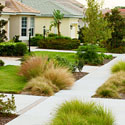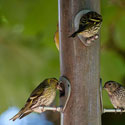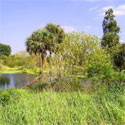Florida-Friendly Landscapes: The Nine Principles
You don’t have to be an expert gardener or landscaper to create a Florida-Friendly yard. All it takes is a willingness to learn and a desire to build a beautiful yard that helps protect Florida’s environment.
Landscaping the Florida-Friendly way means having a beautiful landscape that could save you time, energy, and money while protecting Florida’s future.
Florida-Friendly landscapes protect Florida’s unique natural resources by conserving water, reducing waste and pollution, creating wildlife habitat, and preventing erosion. Any landscape can be Florida-Friendly if it is designed and cared for according to the nine Florida-Friendly Landscaping™ principles, which encourage individual expression of landscape beauty. Find out more from the Florida-Friendly Landscaping™ Program or your county Extension’s FFL program.
Principle #1: Right Plant, Right Place

How well your plants perform depends in great part on whether you choose the right plants for the right place.
Look for low-maintenance plants that are suited to your site and that’ll require minimal irrigation, fertilization, or pest control, once they’re established. Think about how much sun your site receives and choose plants that will work with your conditions.
Consider if you have any wet or dry spots, and group plants based on their irrigation needs. And always take into account how large plants will get before you purchase and plant them.
By choosing the right plant for the right place, you can help create a Florida-Friendly landscape that looks great but also conserves water and protects natural resources.
Principle #2: Water Efficiently
Plants have a specific water requirement to survive and sometimes even plants in the right place will need supplemental watering. Unfortunately, many homeowners overwater.
Overwatering does more than deplete the water supply. It also makes plants prone to pests and adds to stormwater runoff, which pollutes our water resources.
Don’t let the calendar tell you when to irrigate. Look to your plants for telltale signs of water need. Water your lawn only when at least half of it shows wilt. For landscape beds, consider using micro-irrigation systems to put water only where you need it.
If you have an irrigation system, make sure it’s working properly and not watering paved areas.
By choosing drought-tolerant, Florida-Friendly plants and watering correctly, you can reduce water bills, insect and disease problems, and maintenance requirements.
Principle #3: Fertilize Appropriately
Plants need nutrients to grow, and typically get them from the soil. But we sometimes apply organic or synthetic fertilizers to help plants along.
Different nutrients encourage growth in different ways, so do your research before you apply fertilizer. That way you’ll apply the right type of nutrients at the right time.
Plants also benefit from the right amount of fertilizer. Overfertilizing can aggravate pest problems, stimulate excessive growth, and cause pollution of our waterways and groundwater.
Always keep fertilizers off hard surfaces, never fertilize within 10 feet of any water body, and do not fertilize before a heavy rain.
And before you apply fertilizer, make sure you read and follow all label instructions.
Principle #4: Mulch
Mulch is an attractive way to help control weeds, retain soil moisture, and moderate soil temperatures. It gives your landscape a neat, uniform appearance and is a Florida-friendly choice for hard-to-mow slopes and shady spots. Organic mulches can also help improve soil as they decompose.
Many different materials can be used for mulch. Choose environmentally friendly mulch made from melaleuca, eucalyptus, or pine straw or bark. Avoid using cypress mulch, which is often harvested from delicate wetlands.
Let fallen leaves stay under your trees to create self-mulching areas.
Cut down on mowing by replacing grass with mulch in shady areas where grass won’t grow.
Principle #5: Attract Wildlife

We’re lucky in Florida to have incredible wildlife, but natural habitat areas are diminishing. Homeowners can help by creating a welcoming environment for our wild friends.
Wildlife need food, water, cover, and space. Add trees and plants that bear fruit and seed in your landscape. Plant foliage and flowers for butterflies, birds, and bees. Native plants can be a good source of food for animals and insects.
If you don’t have a natural water source, consider building a small pond or placing a birdbath in your landscape. Research what kinds of birds nest in your area, and purchase or build them a home.
Protect your wildlife visitors by limiting pesticide use, or using the least toxic products available.
Principle #6: Manage Yard Pests Responsibly
Pesticides are not always as necessary as people believe. Healthy plants can often tolerate pest attacks, and beneficial insects, birds, and other natural controls can help suppress insect pests.
To minimize problems, choose healthy, pest-resistant plants for your landscape, and use them in the right place.
Scout your landscape often to detect pest problems early. Pick off insects by hand and remove infected areas of the plant.
If you must use a pesticide, use insecticidal soaps, horticultural oils, and other low-toxicity products like Bt. Remember to only treat the affected plants, and to follow all label instructions.
By managing yard pests responsibly, you’ll reduce your impact in the environment.
Principle #7: Recycle Yard Waste
It’s easy to recycle the yard waste left over from mowing, pruning, raking, and other yard work. Plus, it helps return valuable nutrients to the soil.
Start by leaving your grass clippings on the lawn when you mow. Never dump grass clippings or other yard waste into storm drains or waterways. It’s illegal and it pollutes our environment.
Use raked leaves and pine needles in beds as mulch, or add them to the compost pile to create a nutrient-rich soil amendment. You can toss small cuttings from trees and shrubs behind other plantings to recycle their nutrients.
Many communities provide free yard waste pick-up, and they’ll often turn the waste into free or cheap mulch or compost available to homeowners.
Principle #8: Reduce Stormwater Runoff
Rainwater can run off your landscape onto asphalt and other hard surfaces where it can’t penetrate into the ground. But in Florida-Friendly yards, rainwater soaks into the ground and stays on site, helping protect Florida’s waterways.
Reduce the amount of rainfall that leaves your landscape by using porous materials like mulch and pavers for your sidewalks and driveways.
Densely growing turfgrasses and groundcovers help capture rainwater, and can also filter pollutants and reduce erosion.
You can also keep water on site by directing downspouts into landscape beds, planting rain gardens, and using rain barrels and cisterns.
Principle #9: Protect the Waterfront

Florida is filled with lakes, ponds, streams, and rivers. Many homeowners have property adjacent to water, and enjoy the beautiful scenery and fun water-based activities.
Because everything you put in your landscape can wash into the water, waterfront property takes special care.
To protect water bodies from nutrient and pesticide runoff, create a “maintenance-free zone” between the lawn or landscape and the water body. Don’t mow, fertilize, or use pesticides in this area, which should be at least ten feet wide.
Try adding Florida-Friendly, low-maintenance plants in this zone. They won’t require much maintenance, and can help filter out pesticides and fertilizer runoff from adjacent lawns and landscaped areas.
Also on Gardening Solutions
- Gardening with Wildlife
- Minimize Gardening Trial and Error with FFL
- Personalizing Your Florida-Friendly Landscape
- Right Fertilizer, Right Place
- Selecting Plants
- Stormwater Runoff
